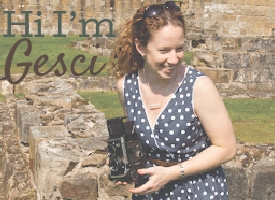As we were driving over to Dryburgh Abbey we drove over a hill and came upon a gorgeous view. Unfortunately I didn't have all my camera gear, just my camera, so there's some sun spots for you, but I've learned that when you're living at 53° (and even Norther on this trip!) the winter sun is LOW. Anyway, it was a gorgeous stop, which explains why there is a layby with a walking path there.
Our third stop on the Border Abbey Tour was Dryburgh Abbey. It was the most secluded of the 4, being the only one outside of a town. Most of what remains of the Abbey was built in the early 13th century, with a good bit remaining from the rebuild following English attacks in both 1322 and 1385, the latter being devastating.
The North Transept from near the the west door of the church.
This sword/cross stands amongst the grave markers in the area that was once just outside the nave wall. The inscription says "This cross of sacrifice is identical with those which stand above the dead of Lord Haig's armies in France and Flanders." Both Field Marshal Earl Haig and Sir Walter Scott are buried at the Abbey.
Sloan atop the corner tower of the presbytery. Paul was under her, holding her harness with two hands!
Yeah... so we may have broken a little rule here. She's a nut.
A bookshelf nook in the east cloister wall. The plaque says "Book cupboard, fitted with doors and shelves (note grooves for shelves)". Clever masons.
The east processional door. Apparently it was removed to a mansion near Kelso for a period of time, but was reinstated at the Abbey in 1894.
More rule breaking. In their defense, Sloan and Max just wanted to experience history by sitting in the same spots in the Chapter House that monks sat in 900 years ago. They're method scholars.
Rose window in the South Range. Part of why this Abbey is so important to historians is that while little remains of the nave and church, many of the outbuildings and living areas are prominent, giving us an idea of the everyday life of the monks.
The gatehouse (with Sloan!) and a view of the South Range behind.
David Steuart Erskine, eleventh Earl of Buchan, was greatly responsible for the preservation of the ruins. He purchased the estate in 1786 and greatly supported the rights of ruins. Despite this mindset, he did some "improvements" he felt appropriate. One of these is the obelisk on the south end of the abbey.
Hugh de Moreville, constable of Scotland and good friend to David I of England, founded the Abbey. I'm not sure if he's represented on both sides of the obelisk or if one side is someone else.
Check out his foxy 'stache! No wonder he was so successful, who can resist that?!?!
Tibetan Cherry tree growing along the path. Nothing important that I know of, just a really pretty tree even without leaves.
Kelso Abbey was unfortunately closed on the day we were there, but it's a fairly sparse ruin in the middle of the town, so we walked around it. It was dusk by the time we were there, so you get a couple of blurry pictures. Note how tall it is: 5 storeys!!
A picture of the inner detail. Sorry I don't really have any more info, since there wasn't a guide book for Kelso.
Going to another country and seeing four abbeys is a long day!! She was sooooo tuckered out!
A picture of the inner detail. Sorry I don't really have any more info, since there wasn't a guide book for Kelso.
Going to another country and seeing four abbeys is a long day!! She was sooooo tuckered out!






























No comments:
Post a Comment
Thanks so much for stopping by! I can't wait to read your comment!